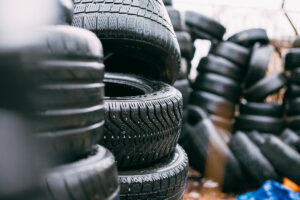Tires are for roads

Used tires, millions of them, usually end up in landfills. People can recycle only so much of them, turning them into planters or trash bins or other things. At some point, in the 1970s-1980s, many used tires ended up in oceans as artificial reefs for aquatic life. But with so many vehicles on the road, electric or otherwise, the world is swamped with used tires.
Fort Lauderdale in Florida used around 700,000 old tires in the 1970s to build an artificial reef to boost fish growth. But they used metal clips to hold the tires together, the Sun Sentinel reported. And those clips were eventually corroded by salt water. Thus, the artificial reef later came loose and floating tires damaged existing coral reefs. Fixing the mess required a massive cleanup.
The Philippines had a similar campaign in the 1980s and 1990s using old tires as artificial reefs. I am uncertain as to whatever became of the effort, and if we had to deal with issues similar to what occurred in Florida. But research now tells us that tires in oceans are a bad idea. Old tires in water eventually degrade into microparticles that pollute the seas.
So, what to do with old tires? Fort Lauderdale eventually opted to burn them for electricity. A 2019 story in National Geographic quoted Reto Gieré, an environmental scientist at the University of Pennsylvania, as saying that if tires were “burned in facilities specifically designed for the task, it can be done fairly cleanly and is a decent way to recapture energy.” But improper burning results in the release of pollutants into the air.
In 1991, a US Federal law required the addition of rubber in the construction of roads that were federally funded. But, with limited technology at the time to mix rubber into asphalt or concrete, the law was repealed four years after. Since then, many states started mixing tire crumbs with asphalt for road construction. The crumbs were produced from grinding old tires.
Today, California state law requires the use of old tire rubber in 35% of paving projects. Chemical & Engineering News (c&en) reported that California also requires that the binder used in surface pavement contain 18-20% rubber by weight. In 2018, the state used an estimated 35,000 metric tons of crumb rubber in its asphalt-paving works.
“Incorporating tire rubber into pavement has benefits beyond just recycling: it increases resistance to rutting, cracking, and aging,” c&en reported. “But the process for making asphalt roads is energy intensive… Researchers have been working to hone the technology for incorporating rubber into pavement to decrease energy use and harmful emissions while increasing durability and life span.”
“They’ve also been experimenting with adjusting processing temperatures, recycling used pavement, and mixing in other types of waste materials, including recycled cooking oil, plastic, and even cigarette butts. Of these salvaged ingredients, however, tires are a proven option,” c&en added.
In my column last week, I wrote about how, as far back as eight years ago, South Korea and the Netherlands have both incorporated solar panels in road construction. In particular, both countries have built solar bicycle lanes where dedicated roads for cyclists are lined with solar panels. In the case of Korea, the panels were used as sunshade. But in the Netherlands, the panels were used as bike paths.
The use of old tires in road construction is nothing new either. The US has been experimenting with it since the 1990s. As a modernizing country, we are also dealing with a tire waste problem. Used tires mostly end up in landfills, when they can instead be used to build more roads. Perhaps we should consider instituting a policy on this.
There should be more emphasis on how to make use of waste in road construction. Plastic waste is now being used for roads in India and other countries. Even locally, San Miguel Corp. has looked into using plastic waste in building roads. In Melbourne, Australia, there have been initiatives to pave highways with crushed glass.
“Developing truly sustainable pavements requires not just incorporating recycled ingredients but also considering their entire life cycle. Ideally, roads would be composed of durable waste materials that allow them to be recycled, forming a zero-waste construction stream,” c&en reported.
Saudi Aramco is also moving to turn old tires into asphalt rubber or AR, noting that “using recycled tires in asphalt pavement has significant environmental benefits, in addition to improved safety and reduced maintenance costs. AR minimizes scrap tires, thereby reducing tire stockpiles that are breeding grounds for a variety of pests, such as mosquitoes and other insects. Tire stockpiles are a prime component of illegal dumping and a source of air pollution when burned.”
In a story in aramcolife.com, the company said it produced a new AR mixture using an “innovative modified dry mix method” with crumb rubber being added directly into the hot mix asphalt, rather than pre-blending them. The AR pavement also used rubber content that was 20% of total asphalt weight, as opposed to the standard 10%.
“AR is a special type of asphaltic paving material in which more than 15% of the binder content is crumb rubber from recycled waste tires. From a pavement engineering point of view, AR offers mechanical properties that are superior to conventional asphalts. As an example, AR has better resistance to permanent deformation… those annoying depressions or grooves worn into the road by heavy haul trucks. AR has greater resistance to oxidation, meaning less cracking of roads. AR pavements also help to reduce roadway noise produced by traveling vehicles, they have a darker tone of black, and a shinier appearance,” aramcolife.com noted.
It’s about time that the Philippines also look into making use of old tires as road-building material. As Highways Today noted, policymakers should be looking into “rubber modified asphalt as a proven circular solution for scrap tires.”
Citing a report by the US Tire Manufacturers Association, in partnership with the University of Missouri and The Ray, a non-profit proving ground for sustainable transportation technologies, it said that “rubber modified asphalt is a resilient pavement solution to rebuild America’s roadways and a promising sustainable and circular end-of-life market for scrap tires.”
“Developing sustainable end-use markets for the 260 million scrap tires generated annually in the US is a top industry priority. Rubber modified asphalt, which incorporates ground tire rubber made from scrap tires into asphalt, provides demonstrated economic, performance and environmental benefits,” Highways Today reported.
“Compared to traditional asphalt, rubber modified asphalt provides cost savings over the life of the asphalt, extends pavement life, and reduces noise, CO2 emissions and tire and road wear particles. Rubber modified asphalt also leads to lower rolling resistance, which helps improve fuel economy,” it added.
With newer research now showing options in dealing with used tires, perhaps our lawmakers should start looking into institutionalizing and incentivizing the manufacture and use of asphalt rubber.
Marvin Tort is a former managing editor of BusinessWorld, and a former chairman of the Philippine Press Council




